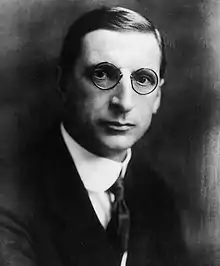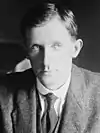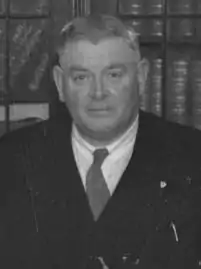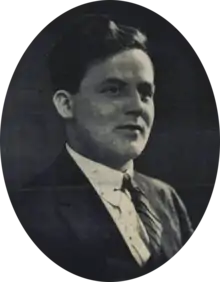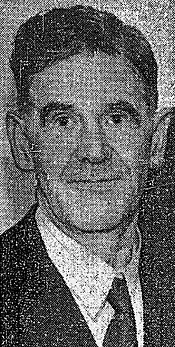1944 Irish general election
The 1944 Irish general election was held on 30 May 1944, having been called on 9 May by President Douglas Hyde on the advice of Taoiseach Éamon de Valera. The general election took place in 34 parliamentary constituencies for 138 seats in Dáil Éireann, the lower house of the Oireachtas (parliament). Fianna Fáil won an overall majority, and when the newly elected members of the 12th Dáil assembled on 9 June, de Valera was re-appointed as Taoiseach at the head of a majority government.
| |||||||||||||||||||||||||||||||||||||||||||||||||||||||||||||||||||||||||||||||||||||||||
137 of 138 seats in Dáil Éireann 70 seats needed for a majority | |||||||||||||||||||||||||||||||||||||||||||||||||||||||||||||||||||||||||||||||||||||||||
|---|---|---|---|---|---|---|---|---|---|---|---|---|---|---|---|---|---|---|---|---|---|---|---|---|---|---|---|---|---|---|---|---|---|---|---|---|---|---|---|---|---|---|---|---|---|---|---|---|---|---|---|---|---|---|---|---|---|---|---|---|---|---|---|---|---|---|---|---|---|---|---|---|---|---|---|---|---|---|---|---|---|---|---|---|---|---|---|---|---|
| Turnout | 69.2% | ||||||||||||||||||||||||||||||||||||||||||||||||||||||||||||||||||||||||||||||||||||||||
| |||||||||||||||||||||||||||||||||||||||||||||||||||||||||||||||||||||||||||||||||||||||||
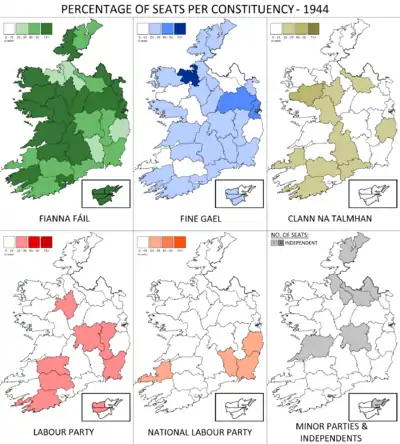 Percentage of seats gained by each of the five biggest parties, and number of seats gained by smaller parties and independents. | |||||||||||||||||||||||||||||||||||||||||||||||||||||||||||||||||||||||||||||||||||||||||
| |||||||||||||||||||||||||||||||||||||||||||||||||||||||||||||||||||||||||||||||||||||||||
The election was fought while the Emergency Powers Act 1939 was still in force and under the terms of the General Elections (Emergency Provisions) Act 1943, which allowed a general election to be called without a dissolution of the 11th Dáil.
Campaign
The outgoing Fianna Fáil government was a minority government. Following a defeat for the second reading of its Transport Bill, Taoiseach Éamon de Valera called a snap election, just one year after the previous election, in hopes of getting an overall majority. The campaign was not wanted by the opposition parties. Technically, and exceptionally, the outgoing Dáil was not dissolved until after the election. Although the Constitution requires the President to dissolve the Dáil before a general election, this procedure was overridden by the General Elections (Emergency Provisions) Act 1943.[1][2][3] The Act, which would have been unconstitutional if not for the state of emergency in effect during World War II, was intended to increase national security by minimising the interval during which no Dáil is in existence.[2] The election was called on 9 May but the Dáil met as scheduled on the following day, when an adjournment debate was held in which the opposition TDs condemned the decision to hold an election in wartime as unnecessary and reckless.[3]
Fianna Fáil fought the election on its record in government and also in the hope of securing a fresh mandate for its policies. During the campaign Fine Gael put forward the proposal of forming a coalition government with the Labour Party and Clann na Talmhan; however, this was ridiculed by Fianna Fáil as untenable. A split in the Labour movement meant that the party was by no means ready to fight an election, and the results showed this.
Due to the fractured nature of the opposition, Éamon de Valera's tactic of calling a snap general election succeeded, as it had in 1933 and 1938.
Result
| 12th Irish general election – 30 May 1944[4][5][6][7] | ||||||||
|---|---|---|---|---|---|---|---|---|
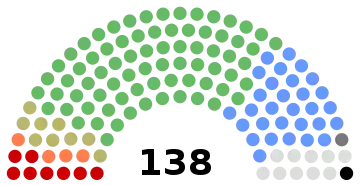 | ||||||||
| Party | Leader | Seats | ± | % of seats |
First Pref votes |
% FPv | ±% | |
| Fianna Fáil | Éamon de Valera | 76 | +9 | 55.1 | 595,259 | 48.9 | +7.0 | |
| Fine Gael | Richard Mulcahy | 30 | –2 | 21.8 | 249,329 | 20.5 | –2.6 | |
| Clann na Talmhan | Joseph Blowick | 9 | –1 | 6.5 | 122,745 | 10.1 | +0.3 | |
| Labour | William Norton | 8 | –9 | 5.8 | 106,767 | 8.8 | –6.9 | |
| National Labour Party | James Everett | 4 | New | 2.9 | 32,732 | 2.7 | – | |
| Monetary Reform Party | Oliver J. Flanagan | 1 | 0 | 0.7 | 9,856 | 0.8 | +0.5 | |
| Ailtirí na hAiséirghe | 0 | 0 | 0 | 5,809 | 0.5 | +0.3 | ||
| Independent | N/A | 10 | 0 | 7.2 | 94,852 | 7.8 | –0.9 | |
| Spoilt votes | 12,790 | — | — | |||||
| Total | 138 | 0 | 100 | 1,230,139 | 100 | — | ||
| Electorate/Turnout | 1,816,142 | 69.2% | — | |||||
- Fianna Fáil majority government formed.
Voting summary
Seats summary
First-time TDs
- Thomas Brennan
- Harry Colley
- Eamonn Coogan
- Walter Furlong
- Michael Lydon
- Patrick McAuliffe
- John S. O'Connor
- Mary Ryan
- Patrick Shanahan (December 1945 by-election)
Re-elected TDs
Outgoing TDs
- Ernest Benson (lost seat)
- W. T. Cosgrave (retired)
- John Esmonde (lost seat)
- James Larkin (lost seat)
- Timothy Linehan (lost seat)
- Jeremiah Ryan (retired)
- Richard Stapleton (lost seat)
See also
- Members of the 12th Dáil
- Government of the 12th Dáil
- Parliamentary Secretaries of the 12th Dáil
References
- "Constitution of Ireland". Irish Statute Book. Article 16.3. Retrieved 27 March 2018.; "General Elections (Emergency Provisions) Act 1943". Irish Statute Book. Retrieved 27 March 2018.
- "General Elections (Emergency Provisions) Bill, 1943—Second Stage". Dáil Éireann debates. Oireachtas. 14 April 1943. Retrieved 15 June 2020.
- de Valera, Éamon (10 May 1944). "Adjournment of the Dáil". Vol.93 No.15 p.3 c.2497–2498. Retrieved 15 June 2020.
I did not ask for a dissolution of the Dáil. This Dáil would not have been meeting to-day if there had been a dissolution. … I did not ask for a dissolution, because we passed an Act last year to enable the Dáil, during this critical period, to be brought together at any time that there was need for doing so, so that the Executive at any time would have to assemble the Dáil in case there was any national issue that demanded its assembly. … when the Dáil adjourns now it will not meet again unless there is some national issue which makes it necessary to call the Dáil together.
- "12th Dáil 1944 General Election". ElectionsIreland.org. Retrieved 2 May 2009.
- "Dáil elections since 1918". ARK Northern Ireland. Retrieved 2 May 2009.
- Maurice Manning (1972) notes that the Clann na Talmhan figure is often listed in error, due to the inclusion of Independent Farmer TDs in the CnaT total.
- Dieter Nohlen & Philip Stöver (2010) Elections in Europe: A data handbook, pp1009-1017 ISBN 978-3-8329-5609-7
Sources
- Manning, Maurice, 1972. Irish Political Parties: An Introduction. Dublin: Gill & Macmillan. ISBN 978-0-7171-0536-6
